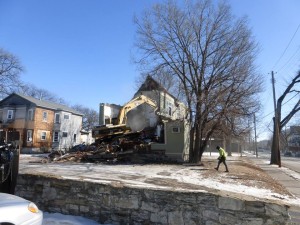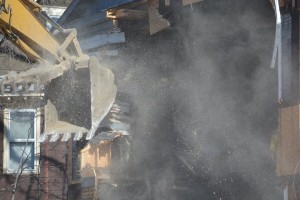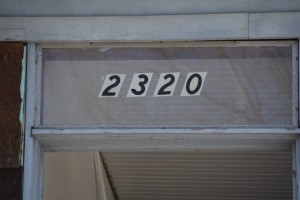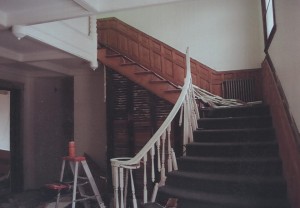
Welcome to the
Healy Project
Join us on Facebook
Send us an Email
Talk: Preservation Advocacy, August 17th

Supporters of the Healy Project gather in front of the Orth House for a photo to be posted on the National Trust’s page, “Places That Matter.”
The story of the fall of the Orth House will be told as part of a talk and exhibit on preservation advocacy sponsored by Preserve Minneapolis and the Preservation Alliance of Minnesota. Anders Christensen of the Healy Project will narrate the two-year- long fight to save the 1893 Healy-built house from demolition. The story of the Orth House, along with other stories of preservation advocacy, will be part of a talk and discussion at the Hennepin History Museum, 2303 Third Ave. South. Thursday, August 17th, 6:30-9:30 p.m. The museum is hosting an exhibit of these stories beginning August 10th.
If you can’t make it to the talk or exhibit, you can read about the fight for the Orth House, its demolition and the aftermath on posts on this blog. It’s a story that’s painful for those of us who fought to save it. . . .and a story that members of the City Council, City Planning, and local developers would like to forget. But it should and must be told.
The deck is almost always stacked against old historic buildings when developers take their promises of higher density and higher tax base to City government. The big triumph over the small, the new over the old, the affluent over those of modest means. The Healy Project will keep fighting as long as old buildings are threatened. And they will always be threatened.
T.B.
Last Friday Minneapolis Mayor Betsy Hodges went on her political Facebook page to take Nicole Curtis to task for her criticism of City Council members. Curtis, the “Rehab Addict” had criticized City officials on her Facebook page for their failure to answer to the corrupted process that led to the demolition of the Orth House on February 25th. Since then, an all-out slugfest has ensued on social media, distracting people from the issue of the lying that went on in public hearings and in District Court about the condition of the Orth House. (See previous posts on this blog.)
Let’s turn our attention away from the demolished Orth House. Let’s cut through the smokescreen issuing from City Hall and focus upon the corrupted process of testimony that brought down the house. Mayor Hodges and CM Bender need to stop pitying themselves and do some explaining about the lack of integrity in the process of testimony before the City Council. Their attack on Curtis, a resident of CM Bender’s ward, is nothing short of self-serving meanness.
Curtis is not just a media star; she is a Minneapolis taxpayer. City officials going after a constituent-critic on social media is unethical, to say the least. Hodges and Bender have gone so far as to kick constituent-critics off their Facebook pages. Democracy in action? If city officials attacked a developer the way they are attacking their own constituents, they’d be slapped with a lawsuit so fast their heads would spin. Apparently, they think it’s OK for those in power to go after private citizens. There oughta be a law. Well, in fact, there is. It’s called the City’s Code of Ethics.
If the goal of these elected officials is to silence their critics, they are not doing a very good job of it. People don’t like feeling shut out of expressing their views to those who represent them. People like even less being fed a load of blather generated from lies as answer to their concerns. 
For the record:
1. The owner of the Orth House filed an appeal to demolish an historic resource. Hodges voted to make it an historic resource in 2013. It became no less historic after CM Bender took office.
To reiterate from a previous post: “At the appeal hearing chaired by CM Bender, both Michael Crow (owner) and John Smoley (Planning staffer) were allowed presentations in favor of demolition. The HPC’s position was reported but not presented; reporting is not a substitute for a persuasive presentation earnestly defending the HPC’s position. It seems appropriate that some provision be made in cases which staff’s professional opinion differs from the decision-making making body.
Something is amiss when the recommendations of both presentations are in agreement with one another. By definition, an appeal is a scenario where one opinion is not in agreement with another.”
In their own defense, City officials trot out the judge’s findings on the Healy Project’s MERA lawsuit to stop the demolition of an historic resource. These findings, like the City Council’s 11-2 vote to demolish the Orth House, were based on false testimony. The lies continue.
2. Mayor Hodges cites a post from a local blogger to document the vulgar comments being made about CM Bender. It turns out that these comments were cut out of threads of many hundreds of comments on Curtis’s “Rehab Addict” Facebook page. Citing this blogger as a credible source of information is like citing Glenn Beck as proof that Obama wasn’t born in the US.
The Twitter feed from this blogger is a nonstop tirade of name-calling against CM Bender’s detractors, including members of the Healy Project. Last year, the blogger doxed Curtis, a single mother. This is as low as you can go. Doxing is a tactic used to threaten and silence women (primarily), so the Twitterer pretending he’s protecting CM Bender from gendered attacks is total hogwash.
The Healy Project conceded that the house’s demolition was a determined matter. We hoped that the process issues could be examined separately from one’s feelings or opinions about the house. CM Bender’s response via posting on Facebook a decision based on the corrupted testimony is a distraction from our inquiry for examination of protocol and process. It’s time for City officials to stop grandstanding and start talking to Minneapolis citizens.
Elected City officials should not be fueling vitriol against their own constituents. If they’re so thin-skinned, they should consider new career paths. Let’s take the “discussion,”if it can be dignified with the term, off Facebook and Twitter and turn to addressing the issue of corrupted testimony. To refuse to do so undermines the public trust.
Until city officials get serious about examining this process, Mayor Hodges, CM Bender, and other officials will have no credibility with many of their constituents.
Their attack on Nicole Curtis has become a national story. Their foolish social media campaign against her has made Minneapolis into a laughingstock.
In January of last year: A political dogfight breaks out in New Jersey after one of the governor’s aides initiated “traffic problems” on a commuter bridge. The issue behind the controversy was lucrative development contracts (what else?). An all-out battle ensued involving the governors of NY, NJ, the Port Authority, and mayors in NJ cities. It was brutal. However, not once did any of them complain that their feelings had been hurt by their political opponents.
No problem was ever solved when those in power refused to sit down and talk. Come on, Mayor Hodges and CM Bender. Get off the low road of social media and get down to fixing problems and moving ahead.
T.B.
On the morning of February 25th, excavation trucks turned up on site at 2316-2320 Colfax Avenue South. Then came the backhoe. By around 9 o’clock, demolition was under way. The backhoe went at the Orth House all day, but still hadn’t completely demolished it. Compare that to the usual time it takes to demolish a modern dwelling–less than an hour.
See video and stills of the demolition here.
Two men worked on the demolition, one on the backhoe and another guy walking around seemingly aimlessly, heedless of peril from lead-filled particulates and falling debris. Neither wore respirators to protect themselves from the toxic dust. At one point the machine operator knocked the chimney and a large chunk of the front gable and cornice onto the front of the backhoe. The site was not roped off, and at times debris fell onto the sidewalk.
Brian Finstad, who watched the demo, reported on this OSHA nightmare: “The Orth House demolition was done without proper procedure for lead containment. Neighbors watched as literally plumes of lead contaminated dust rose into the air and on a very windy day disbursed upon the neighborhood. Only after well into an hour into the demolition (and they probably realized they were being photographed) did they bring out a hose to spray down the dust, but even that was only a token effort and the contaminate continued to disburse into the neighborhood.”
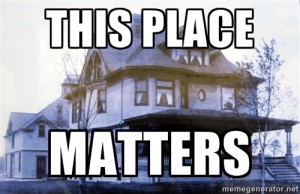
The Orth House, built by master builder T.P.Healy, 1893. Wrecked by Michael Lander, with the aid of CM Lisa Bender, 2015.
Le roi est mort, vive le roi! The Orth House is gone, long live the legacy of T,P. Healy, King of the Queen Anne!
Photo credits: Anders Christensen, Will Lumpkins, Trilby Busch, Bob Roscoe.
–T.B.

The leaded glass transom over the front door in March 2013, removed by the salvage company in December 2014.–Photo by Trilby Busch
A previous post reported that the salvage operation preparatory to the demolition of the 1893 Healy-designed house at 2320 Colfax Avenue South, aka the Orth House, revealed that most of the architectural features of the house were intact.
A subcontractor involved in the salvage operation sent this e-mail to the Healy Project:
“So many people have either lied or credulously accepted lies about the interior of 2320 Colfax. I’d talked my way into a couple of rooms earlier this year so I knew there was more there than they were letting on but I had no idea… The entry, all 3 parlors and the dining room were essentially the same as you see them in those 2 old interior photos on the Healy site. Wainscoting, window & door casings, cove & coffered ceilings, huge paneled pocket doors, it was all there. The cased openings between parlors and about 4 feet of the North end of the dining room were sectioned off with easily removable drywall partitions.
The real surprise, however, was the 2nd floor, purportedly ‘gutted’ by fire. 5 of 6 bedrooms had all of their original millwork, cove ceilings, pocket doors, 10-panel closet doors. One of the bedrooms had a fireplace with a brown ceramic face/hearth and with a cabinet built into the wood surround. The only things new in each of these rooms were their doors communicating to the central hall. Anyone taken upstairs could be easily led to believe that the floor was a drywall gut-job, as long as they were kept in the hallway.
The 3rd floor still had some original millwork but, as was so often the case, it was relatively plain.
Seriously, this could’ve been a million-dollar house.”

This was taken mid-December. It’s from 2320 Colfax, showing part of the coffered ceiling and just a small bit of the wainscoting in the dining room. All of that is either black cherry or 1/4-sawn white oak, painted over with white acrylic. Those panel sections are just 3 of dozens that are in my basement now, along with I’m not sure exactly how many door and window casings (I lost count) – also 1/4-sawn white oak. Many other bits, as we know, are at City Salvage. When I last saw the interior there was a vast amount of mill-work still in place, waiting for the backhoe bucket that will tear it all to splinters. See the link below to some videos and photos taken the week of 9-12 December, 2014. I’m working on some caps from the video as it’s so Blair Witch shaky. Keith Lawrence was in there independently during the day on 9 December. He caught a lot of detail that was already gone by the time I finally got a chance for photos & videos about 12 hours later, in the wee hours of 10 December.–Subcontractor Ezra Gray.
To get to the link showing photos and video taken by Ezra Gray, click here.
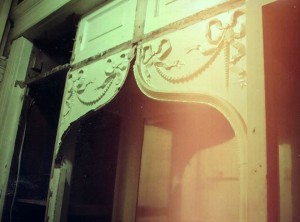
The painted dining room buffet, with its distinctive garlands, being removed for salvage, December 2014.–Photo by Keith Lawrence

The dining room buffet is shown in this century-old photo from the Orth Family collection–Photo courtesy Keith Lawrence
This post will outline the process by which a property owner, by repeatedly lying, finally got City officials to issue a demolition permit for a mostly intact 1893 house that had been declared an historic resource.
Owner Mike Crow repeatedly misrepresented the condition of a house he wanted to sell as land. At neighborhood meetings, before the Minneapolis City Council and Heritage Preservation Commission, and in District Court, Crow asserted again and again that there was nothing left of the original, historic house at 2320 Colfax Avenue South.
At the hearing before the Heritage Preservation Commission on April 13, 2013, Crow testified: “The only pictures he [Anders Christensen] showed you is the only part of the house that still has anything left, and a good portion of that is not the original house. Everything on the second and third floor was completely gutted.”
The Minneapolis Planning Department, apparently eager to get the house down and the Lander Group’s apartment building up, accepted Crow’s word on faith, without visiting the site. Basing his opinion on four exterior photos instead of on an examination of the house itself, John Smoley, preservation expert for the Planning Department, repeated Crow’s assertions: “Fires in 1991 and 2011 have left little interior fabric. The second and third floors have been completely rebuilt [. . . ] 2320 Colfax has extensive integrity issues and is no longer representative of an intact Healy house.”
Thus began the spreading of the big lies about 2320: That fires had destroyed the upper two floors, that the second and third floors had been completely rebuilt, removing all of the original appointments, and that the only original components were those visible in the entryway and a front parlor.
Despite these assertions by Crow and Smoley, the HPC declared the house at 2320 Colfax Ave. S. an historic resource. In May, by unanimous vote, the Minneapolis City Council, after hearing the same testimony that Crow and Smoley had presented to the HPC, reaffirmed the HPC’s declaration. The house was officially declared an “historic resource” of the City of Minneapolis.
However, after the 2013 election, Crow decided to appeal the HPC’s decision. In his request for a permit to demolish an historic resource (January 8, 2014), Crow declared: “We purchased the building in 1991 after it had been severely damaged in a fire. The second and third floors were taken down to the studs and rafters. Nothing on the 2nd and 3rd floor survived other than apiece [sic] of trim here and there, every room in the house had some damage from the smoke, fire or water. There is not one single room that is in its original state. The only two rooms that are the most intact in the entire building are the foyer or entry and the original living room with fireplace.”
Ironically, throughout this process, Crow had been adamant in insisting that if people had seen the house, they would know that his description was accurate—This despite the fact that he had shown the house to several representatives of the Healy Project–but not to John Smoley.
Smoley made his first on-site visit to the house in January 2014 in preparation for the HPC hearing on March 18th. Even after seeing the physical house, in the staff report for the hearing, Smoley repeated Crow’s assertions in architectural jargon:
“The property does not retain integrity of materials. The majority of the building’s original exterior and interior materials have been replaced or covered.. . Remodeling on the first floor has been very heavy, though nowhere near as extensive as on the second and third floor spaces. There, the character is almost completely late twentieth century due to a comprehensive 1980s-era remodel designed to repair fire damage. [. . .] Integrity of workmanship is evident in very few remaining exterior features apart from two bow windows and a brick chimney high atop the roof. On the interior, first floor spaces provide limited evidence of late nineteenth century craftsmanship, separated by far more evidence of late nineteenth century work. In any event, the presence of these few, scattered historic features is not sufficient evidence for this residence to retain integrity of workmanship or integrity in general.”
After hearing their testimony, Commission Sue Hunter-Weir commented: “[A] year ago we looked at this property; we knew about the fire, we knew about the siding, we knew all of those things and still thought of this property as an historic resource and that was appealed to both Zoning and Planning and City Council and they upheld that. So it seems to me like we’re being asked now to say it’s not historic enough.”
The HPC denied Crow’s appeal.

“This Place Matters”, photo taken for uploading to the National Trust for Historic Preservation’s gallery of photos of “places that matter.” May 2014.
Crow then appealed to the City Council. In his “Determination of Historic Eligibility,” Crow sings the same tune, this time with ad hominem attacks (presented here verbatim): “The entrenched foes of new development encouraged the self promoting amateur historian, working in conjunction with a striving TV starlet to generate letters of opposition from folks ignorant of the property. Unwittingly damaging the Preservationist’s cause. With cries of wolf at every new development credibility is diluted, further inhibiting incubation of sound policy. Not everything can be preserved, but if anything it should be the masterpieces. 2320 Colfax was far from a master piece [sic] when it was built much less after three fires, one of which took off the second and third floor.
There is very little left at the property which was built by Mr. Healy.[…]The appellant cites original woodwork, leaded glass and a middle room of the first floor having a fire place. These peices [sic] will surely be saved prior to demolition if they have value. However approximatly [sic] 400 square feet of a total building square footage of over 4,400 means ‘little interior fabric’ of the original remains intact.”
At the April meeting of the Zoning and Planning Committee of the City Council, Crow and Smoley gave basically the same testimony as presented at the HPC. This time, Crow got what he wanted. The committee reversed the previous decisions by the HPC and City Council.
On a motion from new Z&P Chair Lisa Bender, who has publicly supported the Lander development from the outset, the committee approved Crow’s appeal. A month later, the full City Council voted 11-2 to issue the demolition permit for an historic resource. One of the dissenters was 5th Ward CM Blong Yang, who had in fact toured the house. CMs Elizabeth Glidden, Cam Gordon, Barb Johnson, Kevin Reich, and John Quincy, all of whom a year before had declared the house an historic resource, reversed course, and voted for demolition.
When the Healy Project took Mike Crow to District Court for his plans to demolish an historic resource, once again Crow and Smoley repeated their testimony that the upper floors had been burned and rebuilt, that the interior fabric was destroyed, that the house had no integrity of materials, etc., etc.–this time under oath.
These are the facts. All testimony is taken verbatim from the public record.
“. . .at the length, the truth will out.” The Merchant of Venice, Act 2.

The entry hall at the turn of the last century from the Orth Family photo collection.–Photo courtesy Keith Lawrence.
Next: The testimony by the owner’s broker, Tom Dunn (Terra Firma Commercial); the developer’s hired historic preservation expert, Amy Lucas (Principle, Landscape Research); and Pete Keely (Collage Architects) of the Lander Group Development Team–all of which repeated the initial claims of owner Mike Crow.
–T.B.
Attorney Erik Hansen reports that this afternoon Judge Frank J. Magill, Jr. denied the Healy Project’s request for an injunction against the demolition of 2320 Colfax Avenue South, a.k.a. the Orth House.The judge will issue the rationale for the decision at a later date.
This decision comes as no surprise, as the house is already torn apart in preparation for the Lander Group’s backhoes. However, the Healy Project fully intends to take its case to the Court of Public Opinion, where voters, taxpayers, and concerned citizens can decide whether the political process that took down the historic house at 2320 Colfax was fair, unbiased and uncorrupted.

Orth family photos showing the entry hall and dining room of 2320 Colfax. Many of the architectural features shown here are now for sale at City Salvage & Antiques–Photos courtesy Keith Lawrence
Update: In early December, workers at the house told neighbors that Crow owned the house and would be demolishing it before Lander bought the property. Crow’s attorney told the judge that Lander would take possession on December 22nd, the day after the judge would be ruling on the TRO. On New Year’s Eve at the end of a story on 2320 featuring Anders Christensen, KSTP-TV reported that Mike Crow still owns the house and is responsible for demolition. Crow was not available for comment.
Did Crow lie to his attorney, or did his attorney lie to the judge in expectation of getting a $950k bond in case the judge issued the TRO? Or is there another explanation of these conflicting reports? Did the closing take place on the date claimed? Inquiring minds want to know.
To view the KSTP-TV story, click here.
–T.B.
What a difference two weeks makes. Earlier this month, a salvage company began removing architectural components of the Healy house at 2320 Colfax Avenue South in preparation for its demolition. The number of architectural items that came out of that house stunned even those of us who had never believed that nothing was left of Healy’s original 1893 house: fireplaces, doors, millwork, tiles, stained and leaded glass. The items salvaged are now for sale on City Salvage & Antique’s web site, marketed for the exquisite art they are, worth a small fortune.
A subcontractor of City Salvage on December 5 reported: “They wisely got the glass out first. They were busy tonight removing the raised-panel cherry wainscoting from the entry hall and stairs. The oft-discussed original first floor front facade is in fact still there, hiding inside the enclosed porch. Bay windows and bow window side by side, both intact inside and out. They also found a covered ox-eye window on the north wall of the second floor.
All the large doorways communicating 2320’s entry hall, parlors and dining room, each of which had been filled in with drywall and cheap hollow interior doors [by owner Mike Crow], were found still to have 6′-wide, paneled sliding doors hanging intact in their pockets. The Healy signature tile floor uncovered in the vestibule is being removed, destined for re-purpose as a table top.”
These are all things that demolition proponents, including the developer, the owner’s broker, and two preservation experts, claimed repeatedly weren’t there– before the neighborhood association, the Heritage Preservation Commission, the Minneapolis City Council, and, under oath, before District Court.
Photos and video taken on the second floor of 2320 last week and presented in District Court shows that owner Michael Crow gave misleading testimony, repeatedly claiming that the second and third floors were gutted in the reconstruction after the fire in 1991. The details revealed by the salvage operation show his claims to be false. Tom Dunn (real estate broker) of Terra Firma Commercial, the Lander Group (developer), Amy Lucas (historic preservation expert), and City Planner John Smoley all repeated this false testimony. Did they know it to be false or did they fail to do their due diligence?
Anders Christensen and Trilby Busch went on record 43 years ago (November 1981 Twin Cities Magazine article Legacy of a Master Builder) contending that 2320 Colfax is an important part of Healy’s architectural legacy. This claim was made long before the house was threatened with demolition.
In April of 2013, owner Michael Crow told the Minneapolis Heritage Preservation Commission that “everything on the second floor was completely gutted. . .There just isn’t much of the house left.”
Smoley repeated Crow’s misleading testimony: “The interior has been completely lost.” Lucas echoed this, saying, “I don’t know if any of you have been in the house but when it burned, the second and third floors burned completely. So they were rebuilt as small rooms upstairs, so there are sheet rock walls and metal doors.” Dunn summed up these comments with, “There just really isn’t anything worth saving in the building.” Despite these assertions, the HPC declared 2320 an “historic resource.” In May of 2013, the City Council upheld this decision.
However, after the 2013 election, Michael Crow came back to City Hall singing the same tune, but this time to more receptive ears. In March 2014 on a motion by chair Lisa Bender, the Zoning and Planning Committee granted Crow a demolition permit for an historic resource.
Last May, the Healy Project filed suit in District Court to stop the demolition of this historic resource. The case never made it to the trial stage. The Healy Project failed to get a temporary restraining order (TRO) in large part because Crow, Dunn, Smoley, and Lucas once again repeated the false claims initiated by Michael Crow. Since then, the suit has remained on the docket, minus an injunction against demolition.
After the recent revelation that the vast majority of the interior and exterior of the house was intact, the Healy Project decided to revisit the lawsuit. On Friday, December 19th, attorney Erik Hansen appeared in District Court before the Hon. Frank Magill, Jr. to request a TRO, based on the documented revelations of the salvage operation.
Bethany Gladhill, a credentialed expert on historic preservation, testified that in her professional opinion 2320 would be eligible for listing in the National Register of Historic Places, especially if it were included in a Multiple Property Listing of Healy houses in Lowry Hill East. She called 2320 a “transitional” Healy house, in fact, the “lynchpin” in that transition of designs. In her opinion, 2320 has strong integrity of place, of workmanship, and of materials. She respectfully disagreed with several of the findings and the conclusion of Amy Lucas’s report.
Michael Crow’s attorney Steven Harris said the closing between Michael Lander’s development company and Crow is set for Tuesday. It will be Michael Lander’s responsibility to demolish 2320 and the neighboring house at 2316. Crow will receive $950,000 for both properties; Harris requested a bond in that amount if the TRO is granted. A ruling is expected on Monday, December 22nd.
Did Crow lie to his attorney, or did his attorney lie to the judge in expectation of getting a $950k bond in case the judge issued the TRO? Or is there another explanation of these conflicting reports? Did the closing actually take place on the 22nd? Inquiring minds want to know. T.B.]
The next two posts provide detailed documentation of the series of misrepresentations in the testimony of Crow, Dunn, Lucas, Smoley, and the Lander Group throughout the two-year-long series of hearings regarding 2320 Colfax.
“There is only a negligible amount of original trim inside, which is really not worth saving, there’s nothing special about it.” Tom Dunne, President, Terra Firma Commercial, Real Estate Services
“Fires in 1991 and 2011 have left very little interior fabric.” Amy Lucas, Principal, Landscape Research
“Over 75% of the original materials in the home have been replaced due to extensive fires and insensitive remodeling.” Lander Group Development Team, submitted by Collage Architects.
If the above evidence doesn’t convince you that this whole process was poisoned from the start, here are some more statements presented to decision-making bodies, courtesy of Brian Finstad:
“There is not one single room that is in its original state. The only two rooms that are the most intact in the entire building are the foyer or entry and the original living room with fireplace.”
– Mike Crow – Colfax Addendum – 8 Jan 2014
“Besides some wood door frames there is little original fabric at the interior.”
– Amy Lucas, Landscape Research – Report to Pete Keely – 14 Dec 2012
“The interior has been completely lost with the rooming house conversion and fire repairs.”
– Amy Lucas, Landscape Research – Report to Pete Keely – 14 Dec 2012
“Fires in 1991 and 2011 have left little interior fabric . The second and third floors have been completely rebuilt”
– Amy Lucas, Landscape Research – Report to Pete Keely – 14 Dec 2012
“As is common knowledge, the property has endured a number of fires throughout its history with the last fire essentially removing the upper two floors.”
– Assessment of Economic Feasibility of Rehabilitation – Tom Dunn, Terra Firma Commercial – undated
“There is only a negligible amount of original trim inside, which is really not worth saving, there’s nothing special about it. There is one noteworthy concave window on the north side that will be saved, along with a fire place and whatever else there is of value.”
– Assessment of Economic Feasibility of Rehabilitation – Tom Dunn, Terra Firma Commercial – undated
“… the home is nothing close to the original construction. Over 75% of the original materials in the home have been replaced due to extensive fires, and insensitive remodeling.”
– Letter to HPC – Lander Group Development Team; Collage Architects – 17 Feb 2014
“Nearly all of the construction above the first floor and most of the first floor are not Healy constructed components as these have all been replaced… The second and third floors of the structure were gutted down to the studs… nearly all architectural integrity was removed from these two floors …over 70% of the first floor was changed.”
– Letter to HPC – Lander Group Development Team; Collage Architects – 17 Feb 2014
“Fire has gutted the top two floors. Approximately 600 sq.ft. of the total interior has any remains close to the original… There is a fireplace covered with newer construction.”
– Letter to HPC – Lander Group Development Team; Collage Architects – 17 Feb 2014
“The developer will take steps toward preservation. A full photo-documentation of the property interior and exterior will be completed.”
– Letter to HPC – Lander Group Development Team; Collage Architects – 17 Feb 2014
“The second and third floors were burned and the 1992 rehabilitation removed flooring, walls and doors. The plan of the upper floors was also changed during the renovation.”– Historic Evaluation – Amy Lucas, Landscape Research – Mar 2014
Update: On 12/31/2014 KSTP-TV aired a story on 2320 Colfax, featuring an interview with Anders Christensen. To view the story, click here.
–T.B., C.A.C.

On this day that celebrates Planet Earth, residents of our beautiful planet are urged to conserve dwindling resources by recycling everything from plastic bottles to buildings. The “Zero Waste” initiative of the City of Minneapolis similarly encourages citizens to conserve resources:
“Zero Heroes strive to have Zero Waste. They do this by working to first prevent waste, and then by recycling all they can of the waste that remains. To lower this amount of waste we need to take a step beyond recycling: waste prevention. Waste prevention is reducing the amount of waste and the toxicity of waste. Waste prevention saves natural resources, energy, and may even save you money.” City of Minneapolis Web Site

Minneapolis, the Zero Waste city, wants us to recycle and ride bikes–while the City sends hundreds of tons of historic house to the landfill.
However, while the City Solid Waste and Recycling Department is urging citizens to compost and recycle bottles and papers, the City Planning department has been facilitating the demolition of an historic house–which will send 180+ tons of materials to the landfill. This disconnect between saying and doing shows a gobsmacking hypocrisy: Citizens recycle while the City cancels out their efforts by a thousandfold in the demolition of one house.
“The facts are in – no matter how much green technology is employed, any new building represents a new impact on the environment.It makes no sense for us to recycle newspapers, bottles, and cans while we’re throwing away entire buildings and neighborhoods.It’s fiscally irresponsible and entirely unsustainable.”Jerri Hollan, FAIA
“Zero Waste” makes zero sense when the City shows blatant contempt for the most important piece of sustainability–recycling existing buildings. City Planning sent staffer John Smoley to the HPC twice to argue for its “save only the best buildings in the best neighborhoods” policy–and twice, after vigorous debate, the HPC affirmed that that the Orth House, 2320 Colfax Ave. S. is historic and should be placed under interim protection while a designation study is completed. But when the owner’s appeal to demolish was heard before the City Zoning and Planning, CM Lisa Bender, taking the unsupported testimony of the appellants as fact, declared that no viable alternatives existed to wrecking the house, and made a motion to overturn the HPC’s decision. The motion passed with no debate.
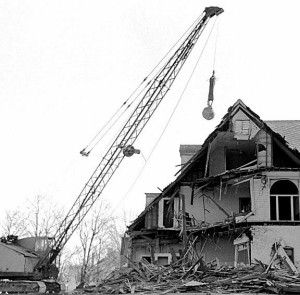
What the City plans for the Orth House and others in the Wedge and other not-good-enough neighborhoods.
“By 2030, we will have demolished and replaced nearly 1/3 of our current building stock, creating enough debris to fill 2,500 NFL stadiums. How much energy does this represent? [E]nough to power California (the 10th largest economy in the world) for 10 years. By contrast, if we rehabilitate just 10% of these buildings, we could power New York for over a year.”UrbDeZine SanFrancisco
The hypocrisy of the City regarding recycling would be laughable if it weren’t so appalling. Minneapolis needs to start practicing what it preaches. Citizens recycling cans and bottles is wasted effort if the government is not encouraging the recycling of buildings.
Don’t jive us, City of Minneapolis. Be a Zero Hero and affirm your alleged commitment to Zero Waste. Allow the historic Orth House to be recycled. The Greenest Building is the one standing.

Demand that Minneapolis, the “Zero Waste” City, allow the ordered designation study for the historic Orth House to be done.

Last week the Minneapolis Zoning and Planning Committee, after listening to an hour of testimony, voted on a motion from CM Bender (Ward 10) to approve the owner’s appeal to demolish the Orth House, 2320 Colfax Ave. S. Lisa Goodman (Ward 7) was the lone dissenter. This vote overturned the decision of the Heritage Preservation Commission to allow the house interim protection (180 days) while a designation study is done. CM Bender must be called to account.
Last year the HPC declared the house to be an “historic resource” and the City Council unanimously upheld this decision. The owner, Michael Crow, and developer, Michael Lander, came back to the HPC this year, saying a designation study hadn’t been done and asking again for a permit to demolish an historic resource. The HPC reaffirmed their previous decision, and ordered a study.
Why wasn’t a designation study done? So far, we have no answer. The issue before the City Council is whether or not viable alternatives to demolition exist for the house. Ignoring the testimony of experts like architect John Cuningham (whose firm did the Uptown small area plan) and structural specialist John Jepsen, who both examined the house inside and out, CM Bender based her opinion on the testimony of those who would reap substantial financial gain from the house’s demolition: the owner, his broker, and the developer.
CM Bender declared that it is not feasible to rehab the house as a single-family home. No one testifying suggested that option, focusing instead on the need for affordable multi-family housing in the city. The owner, Michael Crow, declared that he has spent $250k on improvements to the house. City inspections records show that he spent less than $24k. Last year Crow’s broker, Tom Dunne, when asked directly if he marketed the property on residential MLS, said yes, but admitted this year that he has not. Is the Minneapolis City Council simply going to accept the claims of the owner and broker as fact? Shouldn’t all allegations by appellants be fact-checked by the City?

The City Council should not be taking the word of the owner or developer, or anyone else, on faith. Unless the designation study is done, we have no way of knowing who is giving an accurate, fact-based assessment of the house. Since the vote last year, nothing has changed with the condition of the house or the City ordinances governing historic resources. Ask the CMs on Z&P who voted to grant the house protection last year to justify their change of position (Kevin Reich 1, Barbara Johnson 4). Ask the other CMs who voted last year to follow correct procedure and allow the designation study to go forward (Cam Gordon 2, Elizabeth Glidden 8, John Quincy 11). Copy Mayor Betsy Hodges, who served as CM Ward 13 last year. Ask the new CMs to let the study proceed. Send an e-mail to CM Goodman, thanking her for her support.
Let the City Council’s decision about the Orth House be based on verifiable facts, not the appellants’ unsupported allegations.
The full vote of the City Council on this motion will be held, without public hearing, on Friday, April 25th, at 9:30.
Contact city council members NOW and ask that the City follow correct procedure and allow the designation study to be done. Keep your message short and to the point. Request a response. For a list of current Council members, see http://www.ci.minneapolis.mn.us/council/
 _________________________________________________________
_________________________________________________________
What the facts are:
Re: Sustainability. While the City is touting its “Zero-Waste” initiative, City Council is heading towards approving the demolition of a sound, historic house, sending 180+ tons of materials to the landfill. The City and the developer are using “trickle-down” sustainability, putting the responsibility on the project’s residents, who are expected to sell their cars, bike, use public transportation, and recycle.

Minneapolis, the Zero Waste city, wants us to recycle and ride bikes–while the City sends hundreds of tons of historic houses to the landfill.
Re: Density. The developer claims that his so-called “Eco-flats” will provide needed density on transit hubs, a goal of the City Planning Dept. Density and transit hubs already exist in the Wedge. These amenities are there now, new development or not. The population of the Wedge is being increased by 47% by new development along the Greenway. How much density can the neighborhood absorb?
Re: Neighborhood support. The Lowry Hill East Neighborhood Association does not support the Lander development. A motion to approve the project did not pass the board. A survey of e-mails to the City regarding this issue shows overwhelming support for the house by residents with addresses in the Wedge.
Re: Affordability. Rent in new buildings, to be economically feasible for the developer, must be set at market rate or higher. The 1,800 new units in the Wedge are luxury housing. The Lander project will bring more gentrification, marketing to affluent white people. The affordable housing is the existing houses and apartments, not new construction. A perfect site for an apartment project is available at Franklin and Park. Why doesn’t the City urge Lander to build there, rather than facilitating the wrecking of an historic resource?
Re: Preservation. As noted in the 1981 article in Twin Cities magazine, 2320 Colfax is the transitional design in the career of celebrated master builder Theron Potter Healy. The Heritage Preservation Commission determined that the house is an historic resource. But the City thinks historic houses are worth saving only if they are in “good” neighborhoods. As CM Goodman observed, “This house will see an untimely death as a result of its location. If this was in Lowry Hill or Kenwood we would not be having this conversation.”
STOP DEMOLITION
Ask CMs to pay attention to the presentation of these facts at Z&P last week. Demand that the City follow protocol and allow the study ordered by the HPC to be completed.
Council Members by Ward:
1. kevin.reich@minneapolismn.gov, 2. cam.gordon@minneapolismn.gov, 3.jacob.frey@minneapolismn.gov, 4. barbara.johnson@minneapolismn.gov, 5.blong.yang@minneapolismn.gov, 6.abdi.warsame@minneapolismn.gov, 8.elizabeth.glidden@minneapolismn.gov, 9.alondra.cano@minneapolismn.gov, 10.lisa.bender@minneapolismn.gov,11. john.quincy@minneapolismn.gov, 12.andrew.johnson@minneapolismn.gov, 13. linea.palisano@minneapolismn.gov
Thank Lisa Goodman for her support 7.lisa.goodman@minneapolismn.gov
This Healy house, a design descendant of the Orth House, is on Lowry Hill.
“Merlin, if you don’t stop whining, I’m going to take Gwen’s sword and beat you to death with it,” said Arthur, evenly.
“It’s plastic.”
“So it will take me a long time. I’m still game.”
― FayJay, The Student Prince
 |
| The Orth House later this year? |
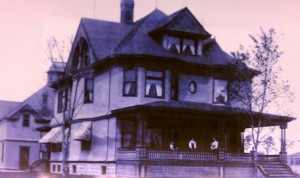 |
| The Orth family on the porch of their house (2320 Colfax S.), 1890s. |

| 1936 photo of Second Ave S. from the 31st Steet intersection |
 |
| The Hudson House in the days before people sitting on the porch didn’t see a freeway across the street. |
 |
| Do not pave up to historic houses. |

